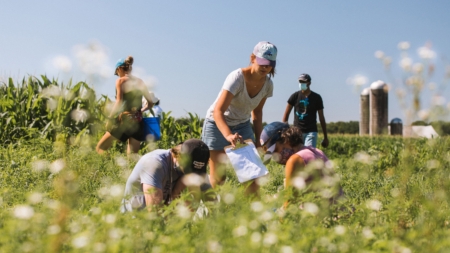What Comes Down Must Go Up
It’s a cold fall morning when I find myself driving a twisting country road through rural Pennsylvania. Just thirty minutes from my suburban enclave, the land shifts dramatically to a pastoral patchwork of emerald green and burnt yellow, peppered by silky black cows. Here, tucked back between storybook-beautiful fields and a scattering of oak trees, Melinda Daniels curls over a contractor’s level, measuring the slope of the ground beneath her muddy rubber wading boots. In a few moments, she’ll turn on the contraption behind her—a towering tripod attached to a hose—and let a torrent of water soak the soil under her tent, which is perched eight feet in the air to help block the wind. It looks like some kind of homespun irrigation project, but the clipboards and measuring tools strewn about expose it as something more precise. This is rainfall simulation, part of a larger scientific study hoping to help solve an ongoing ecological puzzle: how the way we farm affects life off the field.
Daniels is part of a task force of scientists, conservationists and farmers brought together by the Rodale Institute and the Stroud Water Research Center for the Watershed Impact Trial. It’s an unconventional approach, and one of the first studies of its kind taking a long-term scientific look at the connection between different agricultural methods and the health of our lakes, streams and oceans. Until now, cities and suburbs have tried to address the ecological emergency by implementing green infrastructure in an attempt to slow down runoff, often through rain gardens, pervious pavement, green roofing and wastewater treatments. Conservationists scramble to restore wetlands and plant riparian buffers along the shoreline of rivers and lakes to block pollutants from reaching the water. But those efforts aren’t working, at least not efficiently enough. To get to the source of the problem, we have to travel further upstream.
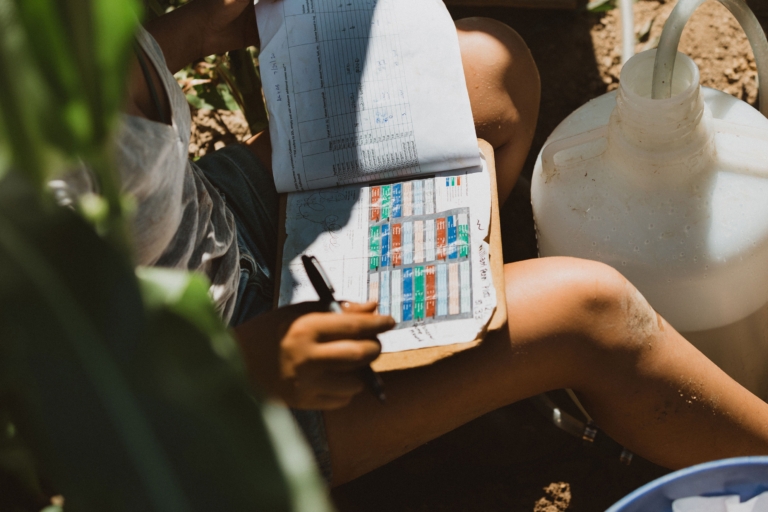
Research interns triple check which farming plot their latest water sample came from before bottling up the day’s work and sending it to the lab. Photo: Johnie Gall
Farmland represents 40 percent of land use in the US, but with more people to feed and clothe than ever, the impacts of agriculture have stepped out of bounds and onto the turf of public lands and waters. A recent report from the EPA suggests the three biggest polluters of fresh water all come from erosion and toxic chemicals used by industrial farms. During heavy rainfall, water that doesn’t soak into the ground washes loose soil into nearby streams and lakes. On conventional farms that treat crops with pesticides, herbicides and fertilizers, the soil is laden with an excess of nitrogen and phosphorous that, when combined with rising water temperatures, creates a kind of superfood for algae. Algae is normally a healthy part of an aquatic ecosystem, but when it grows and decays at such explosive rates, it begins to suck oxygen from the water and creates hypoxic “dead zones”—sometimes called red tides—where few organisms can survive. The most notorious example is the Gulf of Mexico’s dead zone, an area of water the size of New Hampshire experiencing species die-off as a result of algal blooms being fed by chemical runoff in the Mississippi River watershed. A habitat normally teeming with shellfish, red snapper, shrimp and coral has become a biological wasteland.
Though researchers have been aware of the issue for decades, they’re still working to understand how directly it’s being affected by farming, says Pat Glibert, a professor at the University of Maryland Center for Environmental Science. “We’re seeing this phenomenon happening globally and with greater impact as the climate changes,” she explains. “Virtually every freshwater and coastal system is experiencing blooms.” Blooms are proliferating around the world at a rapid pace, a result of the confluence of larger farms and animal operations and stronger, wetter storms brought on by climate change.
Murky red algae ribbons out across the Chesapeake Bay, choking vital bay grasses and decimating oyster harvests. A toxin-secreting blue-green algae spreads across the western basin of Lake Erie, forcing officials to occasionally prohibit swimming and fishing or pause the water supply in Toledo. In 2015, an unprecedented massive toxic bloom stretching from Mexico to Alaska shut down shellfish harvests. Scientists declared it an “unusual mortality event” for large whales, with more than 30 deaths recorded.
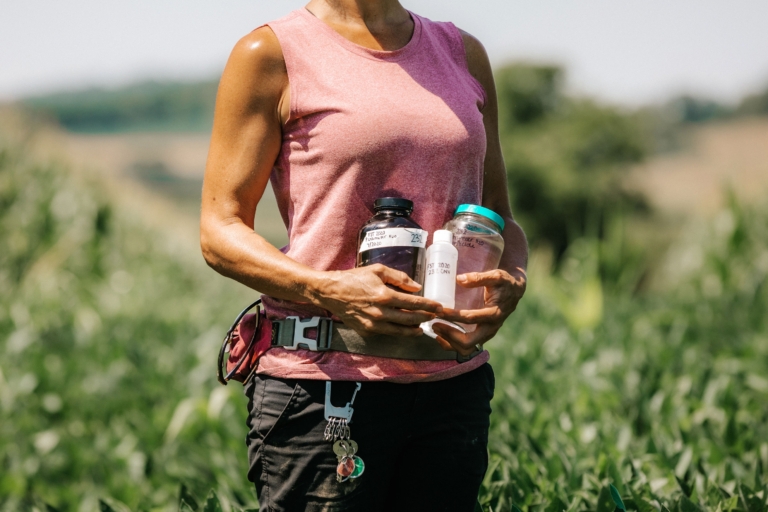
Rodale research coordinator Jessica Lang holds water samples taken from Rodale’s underground reservoirs. Pumping in July means samples are reflective of the activities that have taken place on the farm , such as the application of compost, manure and pesticides. Photo: Johnie Gall
In all that bad news lies some good: If the threats to our water systems begin with farming, so may the solutions. At least, that’s what Daniels is trying to determine as she scratches down figures under her purple tent. What makes the Watershed Impact Trial so unique is its topography: located on 40 acres of sloped land at the Natural Lands Stroud Preserve in Chester Country, Pennsylvania, this sprawling slice of country allows researchers to recreate common storm runoff conditions at such a scale that any data can be extrapolated to apply to large farms. It’s an entire watershed—a stream and all the land that leads to it—up for examination.
“This land has been conventionally farmed for hundreds of years, so we have great baseline data on what that kind of agriculture does. Now we’re transitioning the land to organic and collecting data on the behavior of the soil,” says Daniels.
Researchers from both Stroud and Rodale partnered up to divide the land into four different farming management systems to compare various organic and conventional methods. Some plots grow hay with common conventional chemicals, some without. A few plots use cover crops, others are tilled. They all slope gently toward a stream of water that cuts through the property and into the nearby forest. Over a minimum of six years, scientists will run controlled simulations of rainfall events and extract soil core samples on each plot, examining the quality of runoff, water infiltration, and residues of pesticides and herbicides on crops and in the water.
The study is only in its second full year, so there’s no data published yet, but as we walk through frostbitten fields, the evidence is right there under our feet. Organic soil is vibrant, dark and spongy, while dirt treated with toxic chemicals almost looks sickly, pale and pockmarked with cracks and puddles. In fact, if you put a rounded clump of each type of soil into a bowl of water, chemically starved soil just breaks apart and settles to the bottom, while organic retains its shape.
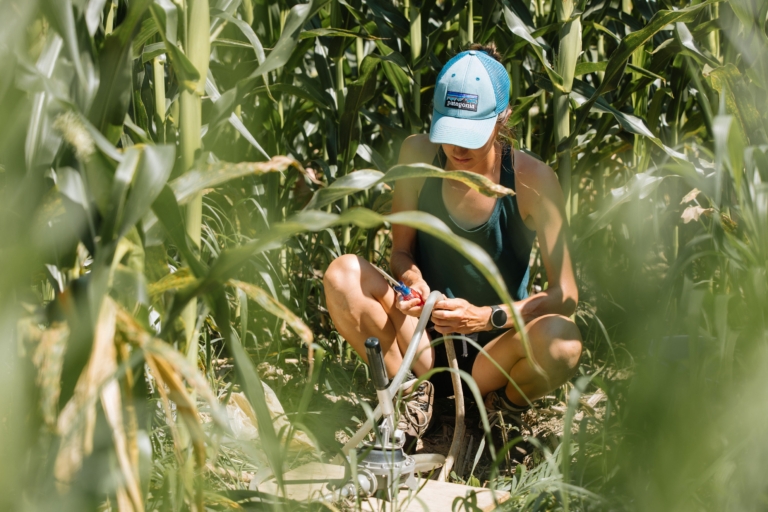
When farming meets science, watch where you step. Research intern Sarah Gray disappears into a corn field to collect water samples (after warning our writer about poison ivy). Photo: Johnie Gall
“The same microscopic systems people are fascinated by in their own guts are also happening in the ground,” says Daniels. “Healthy soil contains a rich microbiome exuding this biological ooze that holds it together, acting like a sponge for water and binding the soil when it rains. In our initial tests, what we found was truly amazing: organic soil, at least on flat ground, has more than double the infiltration capacity of conventional soil.”
As climate change ushers in stronger storms and longer periods of drought, healthy organic soil is a long-term insurance policy. It resists erosion and keeps crops and streams from drying up during seasons of sparse rain and snowmelt. It’s more resilient to the impacts of flooding and outbreaks of disease. It even has the potential to sequester and store carbon from the atmosphere. Which is all well and good in theory, but farming is a business. And like any business, decisions often come down to profit.
Perhaps no one knows this better than Jeff Moyer, the CEO of Rodale Institute and a founding board member of Pennsylvania Certified Organic. As we sit together in a rattling wagon towed by a green tractor through the farm grounds he manages, he admits that the decisions he and other farmers make on caring for their soil need to be founded in data-driven science they can trust.
“The reality of what is happening in your fields is the only thing that matters in farming,” Moyer says, adjusting a pair of wire-frame glasses under his weather-beaten baseball cap. “In the US and around the world, the demand for organic food and fiber is increasing. Farmers transitioning to Regenerative Organic systems are reinvesting in their land and ensuring their soil will be there to produce food long into the future. At the same time, they’re investing in their communities, in the water we drink and the air we breathe. But farmers don’t want to assume that Regenerative Organic practices will help their business or improve water quality in their communities and beyond. They want to see it documented and put with good science.”
Researchers and conservationists can come up with technical soil health solutions, but someone has to actually put those plans into action, which is why Stroud’s watershed conservation coordinator Lamonte Garber believes farmers are such essential—and sometimes overlooked—stakeholders in figuring out how the pieces of this puzzle connect.
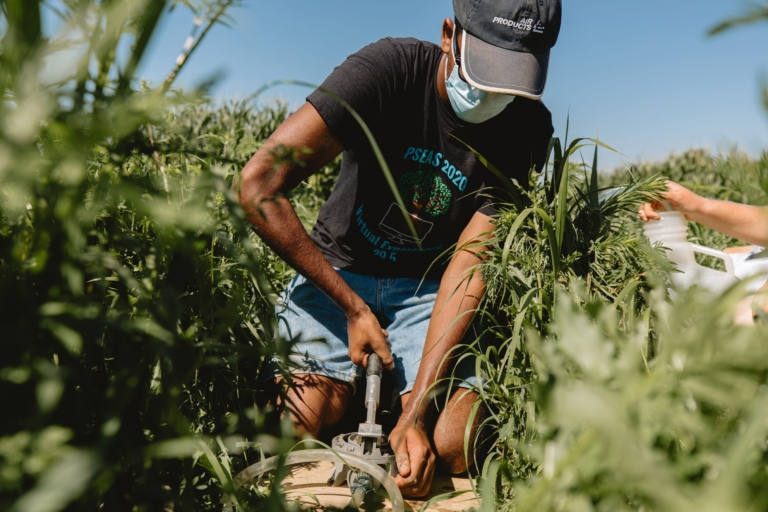
Research volunteer Rahul Inaganti pumps water from a lysimeter during a scorching hot July afternoon. The samples will be tested by researchers for pesticides and biological activity. Photo: Johnie Gall
“Farmers are our advisors for setting up these research projects. We can lay them out with an eye for science, but totally miss aspects of raising crops or the timing of farm operations,” Garber says with palpable energy. “Conservation professionals can come up with great ideas, but a great idea is worthless if it’s not implemented.”
That’s what makes the Watershed Impact Trial unique—because data is being collected on sloped ground and at such a large scale, results will go beyond soil and water science to better understand the effects different systems have on the farmer. By documenting crop yield and energy and emissions use over the next six years, researchers are hoping to produce a data set that empowers farmers to make more informed decisions on land management and advocate for more sustainable farming methods, like organic and Regenerative Organic.

Rodale research coordinator Jessica Lang monitors water sample collection while her interns fix a broken pump back at the truck. “There’s always something to fix,” she laughs. Photo: Johnie Gall
“Our job is to be the nonbiased party evaluating the impacts of farming, whether organic is better or worse than conventional. But it’s important to contextualize the data,” adds Daniels. “We may find that organic no-till farming is the cleanest practice in terms of preserving water quality, but it could also be the most costly to the farmer.”’
“We have to unite conservationists and agricultural leaders to protect our public lands and our public health,” says Diana Martin, Rodale Institute’s director of communications. “It’s time to make organic farming a radical act of conservation.”
